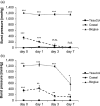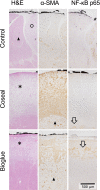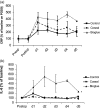Bio-absorbable sealants for reinforcing the pancreatic stump after distal pancreatectomy are critical
- PMID: 30589508
- PMCID: PMC6593819
- DOI: 10.1002/jhbp.604
Bio-absorbable sealants for reinforcing the pancreatic stump after distal pancreatectomy are critical
Abstract
Background: Bio-absorbable sealants are widely used to reduce the rate and severity of postoperative pancreatic fistulas after distal pancreatectomy. However, numerous clinical trials have failed to demonstrate their clinical benefit. We therefore investigated stability and bio-compatibility of absorbable sealants in vitro and in vivo.
Methods: In vitro, polymerized compounds were incubated in pancreatic juice before their stability was tested. In vivo, two compounds were used to seal the pancreatic stump after distal pancreatectomy in nine pigs. Burst pressure of the pancreatic stump, surgical outcome, histology of the pancreatic stump, systemic inflammation, and drain fluid was examined.
Results: Products based on fibrin or collagen were unstable in the presence of active pancreatic enzymes and completely dissolved within 2 h. Sealants using chemical cross-linking of proteins showed improved stability for 7 days. In vivo, application of polyethylenglycol-based sealant leads to complete closure of the pancreatic duct after 5 days, while a glutaraldehyde-based sealant prevented physiological closure of the pancreatic main duct.
Conclusions: Many compounds used clinically to reinforce the pancreatic stump after distal pancreatectomy are inadequate due to instability in the presence of pancreatic enzymes. While selected bio-absorbable sealants inhibited the natural healing of the pancreatic stump, polyethylenglycol-based sealants should be tested in further clinical trials.
Keywords: Adhesives; Animal model; Pancreas; Pancreatic fistula; Polyethylene glycols.
© 2018 The Authors. Journal of Hepato-Biliary-Pancreatic Sciences published by John Wiley & Sons Australia, Ltd on behalf of Japanese Society of Hepato-Biliary-Pancreatic Surgery.
Conflict of interest statement
None declared.
Figures







References
-
- Fahy BN, Frey CF, Ho HS, Beckett L, Bold RJ. Morbidity, mortality, and technical factors of distal pancreatectomy. Am J Surg. 2002;183:237–41. - PubMed
-
- Hassenpflug M, Hartwig W, Strobel O, Hinz U, Hackert T, Fritz S, et al. Decrease in clinically relevant pancreatic fistula by coverage of the pancreatic remnant after distal pancreatectomy. Surgery. 2012;152:S164–71. - PubMed
-
- Knaebel HP, Diener MK, Wente MN, Büchler MW, Seiler CM. Systematic review and meta‐analysis of technique for closure of the pancreatic remnant after distal pancreatectomy. Br J Surg. 2005;92:539–46. - PubMed
-
- Diener MK, Seiler CM, Rossion I, Kleeff J, Glanemann M, Butturini G, et al. Efficacy of stapler versus hand‐sewn closure after distal pancreatectomy (DISPACT): a randomised, controlled multicentre trial. Lancet. 2011;377:1514–22. - PubMed
-
- Sheehan MK, Beck K, Creech S, Pickleman J, Aranha GV. Distal pancreatectomy: does the method of closure influence fistula formation? Am Surg. 2002;68:264–7. - PubMed
Publication types
MeSH terms
Substances
LinkOut - more resources
Full Text Sources
Molecular Biology Databases

